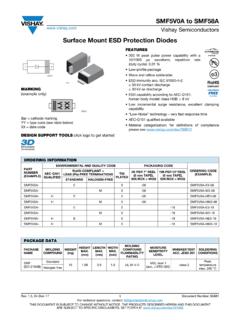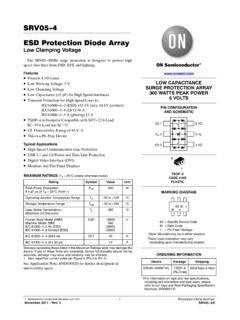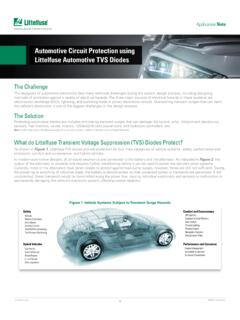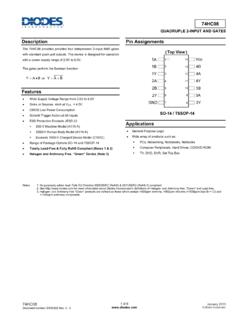Transcription of MT-036: Op Amp Output Phase-Reversal and Input Over ...
1 MT-036. TUTORIAL. Op Amp Output Phase-Reversal and Input Over-Voltage protection OP AMP Output VOLTAGE Phase-Reversal . This tutorial discusses two related topics related to op amps: Output phase reversal, and Input over-voltage protection . Output voltage Phase-Reversal is a problem that occurs in some op amps when the Input common-mode (CM) voltage is exceeded. It is usually caused when one of the internal stages of the op amp no longer has sufficient bias voltage across it and subsequently turns off. This causes the Output voltage to swing to the opposite rail until the Input comes back within the common- mode range, as shown in Figure 1 for a voltage follower. Note that the inputs may still be well within the supply voltage rails, but simply above or below one of the specified CM limits. Typically, this is towards the negative range, and Phase-Reversal is most often associated with JFET and/or BiFET amplifiers, but some bipolar single-supply amplifiers are also susceptible to it.
2 Figure 1: Output Voltage Phase-Reversal in a Voltage Follower Although Phase-Reversal is usually a temporary condition, it can be disastrous if the op amp is within a servo loop. Phase-Reversal is most likely to occur when the op amp is configured as a unity-gain voltage follower. In the inverting mode Phase-Reversal is not a problem because both inputs are constant and at ground (or mid-supply in some single-supply applications). , 10/08, WK Page 1 of 9. MT-036. Circuit design techniques are used so that most modern op amps do not suffer from phase- reversal. If the op amp is designed to avoid Phase-Reversal , it is generally noted on the data sheet in the Key Features table, but not necessarily in the specification table. In the case of "rail-to-rail" Input op amps, the Input CM voltage includes the rails; therefore, the op amp should not exhibit Phase-Reversal as long as the Input voltage does not exceed the rails.
3 Figure 2 shows the "Key Features" and absolute maximum specifications for the AD8625 (quad), AD8626 (dual), and AD8627 (single) op amp family. These amplifiers have JFET inputs and an Input CM voltage range of 0 V to +3 V (maximum) when operating on a single +5 V supply. The "no Phase-Reversal " specification means that the Output will not exhibit Phase-Reversal in the CM. region of +3 V to +5 V. Figure 2: "Key Features" and Absolute Maximum Specifications for AD8625/AD8626/AD8627 Op Amp Some op amps may exhibit Output voltage Phase-Reversal only when the Input exceeds the supply rails. However, this condition violates the absolute maximum specification for the Input voltage and should be avoided. If Input over-voltage conditions are possible, appropriate protection circuits should be added. In most cases these protection circuits will also serve to prevent Output voltage Phase-Reversal as described next.
4 Page 2 of 9. MT-036. Input OVER-VOLTAGE protection AND Output Phase-Reversal . protection CIRCUITS. The absolute maximum ratings are the voltage, current, and temperature limits beyond which an IC op amp will suffer damage. Applying over-voltages to Input pins a common way to damage or destroy or an op amp. Over-voltage conditions can be broken into two catagories: over- voltage and electrostatic discharge (ESD). ESD voltages typically are in the thousand of volts. Most of us have experienced ESD. Shuffle your feet across a nylon carpet, especially in a dry environment, and touch a metal doorknob. Sparks will fly from your fingertips. CMOS circuits are especially prone to ESD damage, but bipolar circuits can be damaged also. Most op amps have internal ESD protection diodes on the Input pins to allow the ICs to be handled during the PC board assembly phase. These diodes are small to minimize capacitance and leakage, and are not designed to handle sustained Input currents greater than a few mA.
5 Whenever an op amp Input common mode (CM) voltage goes outside its supply range, the op amp can be damaged, even if the supplies are turned off. Accordingly, the absolute maximum Input ratings of almost all op amps limits the greatest applied voltage to a level equal to the positive and negative supply voltage, plus about V beyond these voltages ( , +VS + V, or VS V). This rule of thumb applies even if the absolute maximum Input voltage is specified as the supply voltages (as is the case in Figure 2). While some exceptions to this general rule might exist it is important to note this: Most IC op amps require Input protection when over-voltage of more than V beyond the rails occurs. The failure mechanism is not the over-voltage per se, but the current that the over-voltage causes to flow into the Input pin. If the Input current is limited to no more than 5 mA (a good rule of thumb), no catastrophic damage will be done.
6 However, continually overstressing the inputs can cause a change in parameters, such as bias current and offset voltage. Even though it may not necessarily destroy the op amp, over-voltage should therefore be avoided if at all possible. protection for over-voltage usually consists of adding both external diodes from the Input pins to the supplies as well as current limiting resistors (see Figure 3). The diodes are typically Schottky diodes, used because of their lower forward voltage (typically 300 mV vs. 700 mV for silicon). These protection devices should be applied with caution however. Some diodes can be very leaky, and the additional leakage current essentially adds to the op amp bias current. Some diodes can also have fairly high capacitance, which may limit frequency response. This is especially true for high speed amps. The addition of the external current limiting resistor RLIMIT.
7 Also adds noise. Page 3 of 9. MT-036. +VS. RLIMIT D1. 1k 1N5711 + INTERNAL ESD. VIN. protection DIODES. I LIMIT IIN(MAX). < 5mA. VOUT. D2. 1N5711. CF. _. RFB. -VS 1k . Figure 3: A General-Purpose Op Amp Over-Voltage protection Network Using Schottky Clamp Diodes with Current Limit Resistance Unless otherwise stated on the data sheet, op amp Input fault current should be limited to 5 mA. to avoid damage. This is a conservative rule of thumb, based on metal trace widths in a typical op amp Input . Higher levels of current can cause metal migration, a cumulative effect, which, if sustained, eventually leads to an open trace. Should a migration situation be present, failure may only appear after a long time due to multiple over-voltages, a very difficult failure to identify. So, even though an amplifier may appear to withstand over-voltage currents well above 5 mA for a short time period, it is important to limit the current to 5 mA (or preferably less) for long term reliability.
8 Some op amps, such as the OP27, include protection diodes, but still require current limiting. If an op amp has protection diodes it will typically have a spec for maximum differential Input current. The protection circuit should also show up on the simplified schematic. Some op amps also have back-to-back diodes across the inputs. These are not for Input over- voltage protection , but to limit the differential voltage. If these exist, there will be an absolute maximum spec of 700 mV for the differential Input voltage. The circuit in Figure 3 is a general-purpose op amp CM protection circuit. With appropriate selection of these parts, Input protection for a great many op amps can be ensured. Note that an op amp may also have internal protection diodes to the supplies (as shown) which conduct at about V forward drop above or below the respective rails. In this case however, the external Page 4 of 9.
9 MT-036. Schottky diodes effectively parallel any internal diodes, so the internal units never reach their threshold. Diverting fault currents externally eliminates potential stress, protecting the op amp. The external diodes also allow other degrees of freedom, some not so obvious. For example, if fault current is allowed to flow in the op amp, RLIMIT must then be chosen so that the maximum current is no more than 5 mA for the worst case VIN. This criterion can result in rather large RLIMIT values, and the associated increase in noise and offset voltage may not be acceptable. For instance, to protect against a VIN of 100 V with the 5 mA criterion, RLIMIT must be 20 k . However with external Schottky clamping diodes, this allows RLIMIT to be governed by the maximum allowable D1-D2 current, which can be larger than 5 mA. However, care must be used here, for at very high currents the Schottky diode drop may exceed V, possibly activating internal op amp diodes.
10 It is very useful to keep the RLIMIT value as low as possible, to minimize offset and noise errors. RLIMIT, in series with the op amp Input , produces a bias-current-proportional voltage drop. Left uncorrected, this voltage appears as an increase in the circuit's offset voltage. Thus for op amps where the bias currents are moderate and approximately equal (most bipolar types) compensation resistor RFB balances the dc effect, and minimizes this error. For low bias current op amps (Ib . 10 nA, or FET types) it is likely RFB won't be necessary. To minimize noise associated with RFB, bypass it with a capacitor, CF. FIXES FOR Output PHASE REVERSAL. In many cases, the addition of an appropriate RLIMIT resistor will prevent Output Phase-Reversal . However, many op amp manufacturer might not always give the RLIMIT resistance value appropriate to prevent Output Phase-Reversal .
















